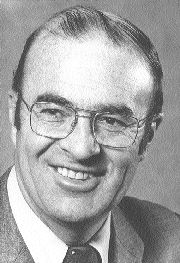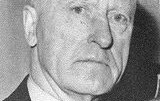Norman B. Keevil, the man best-known for taking middling Teck Corp., with a couple of small gold mines, and building it into a base metals powerhouse, will be among four new inductees into the Canadian Mining Hall of Fame. All four will be honoured at an awards banquet on Jan. 15, 2004, at the Fairmont Royal York Hotel in Toronto.
Joining Keevil will be former Falconbridge executive Michael Knuckey, coal industry visionary Walter Riva, and Edgar Scholz, the former Placer Development executive known for developing large-scale, low-grade mines.
Norman Keevil (b. 1938)
Keevil, an explorationist, entrepreneur and scientist, contributed greatly to his industry.
Born in Cambridge, Mass., Keevil obtained in 1959 a bachelor of science degree in applied geology from the University of Toronto, and later a PhD from the University of California (Berkeley) in 1964.
He joined Teck Corp. in 1962 and became president and CEO in 1981, chairman in 2000, and non-executive chairman in 2001.
Teck started with a few small gold mines in Ontario and Quebec and by the early 1970s was worth about $50 million, with most of its revenue coming from oil.
Following a number of amalgamations, a merger, and a name change, Teck Cominco, as it is now known, has gold, base metals and coal mines in Canada, the U.S. and Peru, and refining operations in Canada and Peru. The company is the world’s largest zinc miner. In 2002, its revenues were $2 billion, and its market capitalization is more than $5 billion.
Keevil believed a successful mining company required three things: good orebodies, the capital to develop these, and good people to ensure that everything runs smoothly. Not exactly groundbreaking stuff, but he believed in keeping things simple.
At home, Teck developed the Afton and Highland Valley copper mines and Bullmoose coal mine in British Columbia; the David Bell and Williams gold mines in Ontario’s Hemlo camp; a niobium mine in Quebec; and Newfoundland Zinc at Daniel’s Harbour. The company also reorganized the Quintette and Elkview coal mines in British Columbia.
Abroad, its interests include the Tarmoola gold project in Australia, Quebrada Blanca copper in Chile, and, through Cominco, the Red Dog lead-zinc project in Alaska.
More recently the company developed the Carosue Dam gold mine in Australia, and with its partners expanded Red Dog and brought the Antamina copper-zinc mine in Peru into production.
Keevil has a knack for shrewd deal-making, one example being Voisey’s Bay. A 10% interest in the discovery, for what appeared to be a premium price of $108 million, appreciated to more than $500 million within a year.
In 1986, Teck joined with Metallgesellschaft and MIM to buy a 31% interest in Cominco from Canadian Pacific for $280 million. Eventually it bought out its partners and in 2001 acquired the remaining interest to hold 100%.
Keevil’s strategy then turned to “adding balance.” In 2003, Teck Cominco merged its Elkview coal mine with the metallurgical coal mines of Fording Coal and Luscar to form the Elk Valley Coal Partnership. Elk Valley is now the world’s second-largest producer of metallurgical coal.
For decades, Keevil has worked with prospectors and developers among the Canadian junior mining companies, and throughout times of volatile metal prices and difficult financial circumstances, he has worked with government to the benefit to the entire industry.
He has built bridges between academic research and industry. The Norman B. Keevil chair in mineral exploration at the University of British Columbia, established by Teck Cominco, has raised the level of research activity and the profile of mineral exploration. In addition to his support for UBC, Keevil has helped establish the Teck chair in exploration geophysics at the University of Toronto, a scholarship in earth science at the University of Western Ontario, and a Canadian mining chair at the mining centre of the engineering faculty of the Pontificia, Universidad Catolica de Chile.
He also served as chairman of the Ottawa-based Mining Association of Canada.
The Northern Miner elected him Mining Man of the Year in 1979, and the Vancouver Jaycees appointed him Businessman of the Year in 1987.
Michael J. Knuckey (b. 1936)
Knuckey played a role in the discovery or development of at least 10 mineral deposits, most notably Raglan in northern Quebec and Collahuasi in Chile. Of these deposits, eight have become mines.
His support of the Raglan project in northern Quebec resulted in an agreement that has become the textbook model for dealing with First Nations communities.
Born in Cornwall, England, Knuckey graduated in mining geology from the Royal School of Mines in London and emigrated to Canada in 1957. He worked in New Brunswick, at Elliot Lake in Ontario, and in Quebec, where he became manager of the Coniagas mine. He later joined Falconbridge as chief geologist at La Luz Mines in Nicaragua.
After a year of post-graduate studies in the U.K., he rejoined Falconbridge in Timmins, Ont., in the early 1970s, subsequently joining Falconbridge Copper as chief geologist. In 1982, he was appointed the company’s vice-president of exploration, and four years later he assumed the same title with its parent company, Falconbridge.
In 1995, as Falconbridge and Noranda moved closer together as companies, he was appointed president and CEO of Noranda Mining & Exploration. Two years later, after Noranda reorganized its smelting and mining assets, he became executive vice-president of exploration and project development.
Throughout his 45 years in the industry, Knuckey has been involved in the discovery and development of numerous deposits. Collahuasi in Chile is one excellent example. He also guided exploration teams in the discovery of seven other deposits of different geological types, which have resulted in mines. These are: the Corbet copper-zinc-gold-silver mine, and the Ansil base metals and Winston Lake gold projects in Quebec; the Samatosum massive-sulphide deposit in British Columbia; the Thayer-Lindsley nickel mine in northern Ontario; Raglan’s new zones in far northern Quebec; and the Ujina copper deposit in Chile.
Knuckey instilled in his exploration teams the need to compile rigorously all geological data, particularly drill-hole information, and to prepare folios of level plans from which longitudinal and cross-sections could be compiled. This approach resulted in his first new discovery, the Corbet deposit in 1974. Layers with lithogeochemical and geophysical data were soon incorporated into the folio system.
Several new technologies are now standard in exploration as a result of the financial support given to them by Knuckey. Lithogeochemistry and borehole geophysical studies led to the Ansil discovery (a mile below surface), as well as Winston Lake.
His achievements have already been recognized by the Geological Association of Canada, the Prospectors & Developers Association of Canada, the Canadian Institute of Mining, Metallurgy and Petroleum, and the Society of Economic Geologists.
Walter J. Riva (b. 1922)
Born in 1922 in Canmore, Alta., Riva was a tireless leader of Canada’s coal mining industry.
After serving with the Royal Canadian Air Force during the Second World War, he began his career as a labourer at Canmore Mines’ coal operations while studying mining engineering at the University of Alberta.
He graduated in 1949 and joined Canmore full time, eventually becoming executive vice-president and CEO. He moved on to Denison Mines, and then to Kaiser Resources, first as vice-president of coal mining operations at Sparwood, B.C., then as president of its coal division — the first Canadian to hold these positions. When Kaiser was acquired by British Columbia Resources Investment Corp. in 1980, Riva became president and CEO, and then chairman and CEO. In 1983, he retired from management to serve as vice-chairman of Westar Mining, and then chairman of B.C. Resources, until his retirement in 1986.
A pioneer, Riva developed new markets and introduced new technology and procedures.
He introduced mechanized mining at Canmore, using continuous miners and shuttle cars to improve productivity and safety. Under his guidance, the Kaiser mines introduced an efficient fleet of large, 200-tonne dumptrucks for moving overburden. Later, a 350-tonne dumptruck prototype was tried out, many years before it became the standard in mining.
He also engineered the sale of Canadian coal to Asian markets, such as Japan and Korea. He worked closely with the Canada Centre for Mineral & Energy Technology to develop a form-coking process that served a higher-value niche market in the electric furnace field.
Riva was a founding member of the Coal Association of Canada and served as its president. He presided over the Canadian Institute of Mining, Metallurgy and Petroleum from 1984 to 1985 and received the CIM’s coal award in 1991.
Edgar A. Scholz (1915-1980)
Scholz was among the first to understand that low-grade copper, molybdenum and gold deposits could be mined profitably through the development of a large-scale open pits.
He helped build Placer Development (now Placer Dome) by introducing and guiding the application of low-cost bulk-mining worldwide.
Scholz was a man of strong and independent convictions, and one of his strongest beliefs, even in the 1950s, was that the price of gold would eventually rise dramatically. He guided Placer accordingly.
Born in Sand Coulee, Mont., he began work as a miner in Butte. After several years in a number of small mines, he enrolled at the Montana School of Mines, receiving, in 1941, a bachelor of science degree in geological engineering. From 1942 to 1945, he worked with the U.S. Geological Survey (USGS) in the Western Mineral Deposits branch. Among other accomplishments, he conducted the fieldwork for two scientific publications: USGS Professional Paper Geology and Ore deposits of the Bagdad District, Ariz. (1955); and USGS Bulletin Molybdenum Deposits of the United States (1964). The former, co-authored with C.A. Anderson, developed a model for understanding the geological environment for porphyry copper deposits. The molybdenum bulletin quickly became the handbook for those seeking molybdenum deposits south of the border.
From 1946 to 1956, Scholz was the senior executive and managing officer of several successful small mines producing gold, copper, zinc and tungsten in Montana and Arizona. In 1956, he joined Placer subsidiary American Exploration & Mining Co. in San Francisco, Calif., and later became its vice-president and director.
In 1956, he made a field examination of the Marcopper porphyry copper prospect in the Philippines. A recommendation was made for Placer to do further exploration, which continued until the property was brought into production in 1969.
In 1961, Scholz moved to Placer’s head office in Vancouver; there, he served as manager of exploration and eventually became vice-president of exploration. He was involved in the examination of data on the Craigmont property near Merrit, B.C., and recommended that Placer participate. It was eventually developed as an open pit.
For Placer, Scholz made the initial field examination of the molybdenum property in Endako, B.C., and negotiated an option to acquire it. An aggressive exploration program was carried out and the mine was brought into production in 1965 as a 10,000-tonne-per-day open pit. The average grade of the ore was so low that many were skeptical of the mine’s viability, yet the project was both a technical and economic success, persuading Placer to focus on large, low-grade deposits amenable to open-pit mining. An early result was the acquisition of the Gibraltar Mines copper deposit near Williams Lake, B.C.
Placer grew rapidly, building Marcopper in the Philippines, the McDermott mercury and Cortez gold mines in Nevada, the Golden Sunlight gold mine in Montana, the Kidston gold mine in Australia, and the Porgera and Misima gold mines in Papua New Guinea. All of these large, open-pit deposits were put into production within a period of less than 20 years.
Scholz retired from Placer in 1976 and established Scholz International Mining, a consulting firm. He was instrumental in the formation of Pegasus Gold Mines, whose early success was built on his knowledge of the extremely low-grade gold deposits at Zortman and Landusky in Montana, near where he was born.
Scholz served as president of the British Columbia and Yukon Chamber of Mines in 1973-74, and in 1978 was general chairman of the CIM’s annual meeting in Vancouver.






Be the first to comment on "Keevil heads 2004 inductees into Canadian Mining Hall of Fame"